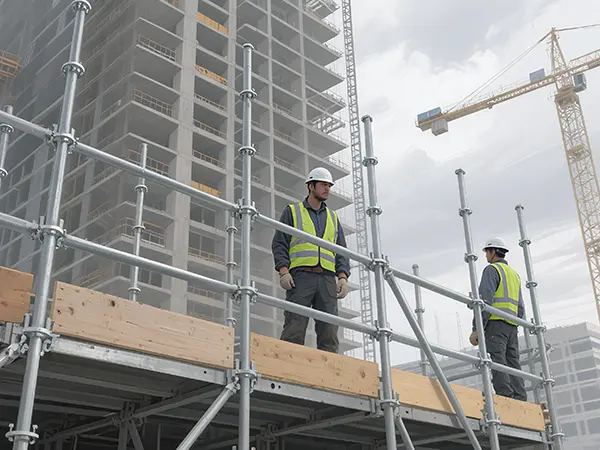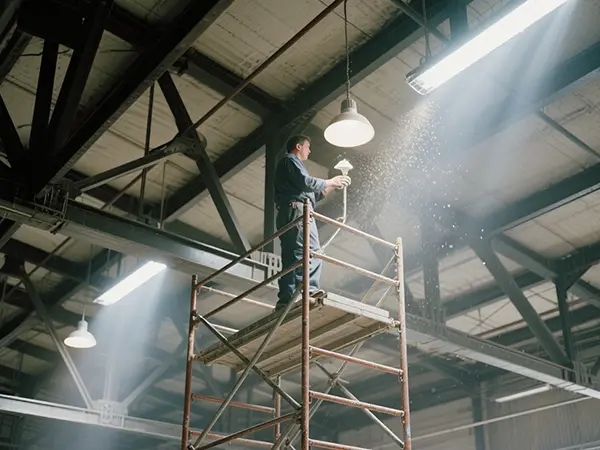A scaffold, at its core, is a temporary framework. Its primary job is to offer a stable and safe working platform for people carrying out tasks at heights, as well as to provide support for materials and tools .

The concept of scaffolds isn’t new; it has evolved significantly over time. While wooden and bamboo scaffolds were common historically and are still used in some regions, modern scaffolding predominantly uses steel and aluminum for their superior strength, durability, and safety .
The key purposes of using a scaffold include:
- Ensuring worker safety at elevation.
- Providing efficient access to high, hard-to-reach areas.
- Supporting materials and tools needed for the job.
- Occasionally acting as a template for certain construction phases .
Beyond their physical form, the term ‘scaffold’ also appears in fields like education (as a learning support technique) and software development (as a tool to generate project structures) , showcasing its fundamental concept as a supporting framework.
What are the Different Types of Scaffold Systems?
Scaffold systems aren’t one-size-fits-all; they come in various forms to suit different project needs. Understanding these types helps in selecting the right one for the job.
Here’s a quick overview of common scaffold types:
| Scaffold Type | Primary Use Case | Key Advantage | Consideration |
|---|---|---|---|
| Tube and Coupler | Complex structures, irregular shapes | High flexibility and adaptability | Requires more skill and time to assemble |
| Prefabricated Modular | General construction, straightforward facades | Quick and easy assembly | Less flexible for non-standard shapes |
| H-Frame / Façade | Large façade projects, simple access needs | Simple and efficient for repetitive structures | Limited application versatility |
| Suspended | High-rise building maintenance | Can be raised/lowered; ideal for maintenance | Not for new construction from ground up |
| Mobile / Rolling | Projects requiring frequent lateral moves | Portability for tasks like overhead installation | Must be immobilized during use |
| Timber | Traditional projects, specific regional use | Readily available materials in some areas | Generally less sturdy and safe than metal |
The most common types you’ll encounter in industrial settings include:
- Tube and Coupler Scaffolds: Made from individual tubes connected by special couplers. This type is highly flexible and can be adapted to complex structures and irregular shapes .
- Prefabricated Modular System Scaffolds: These consist of pre-made modules that easily connect together. They are popular for their speed and ease of assembly .
- H-Frame / Façade Modular System Scaffolds: Characterized by their simple, repeated H-shaped frames. They are very efficient for large projects with straightforward facades .
- Suspended Scaffolds: These are lowered from the top of a structure (like a building roof), often using ropes or chains. They are common for maintenance work on skyscrapers, such as window washing or exterior repairs.
- Mobile or Rolling Scaffolds: Mounted on casters or wheels, making them easy to move around. Locking mechanisms on the wheels are absolutely critical to prevent movement while the scaffold is in use. They are excellent for tasks like overhead installation in a large room.
- Timber Scaffolds: While less common in modern industrial applications due to safety regulations, they are still used in some regions and for specific traditional projects .
The choice of scaffold system depends on factors like the nature of the work, building shape, required load capacity, height, and project duration.
How to Build a Scaffold System: A Step-by-Step Guide
Building a scaffold, especially a large or complex one, should be done by trained personnel following strict safety protocols. Here is a generalized overview of the process for building a common framed scaffold system.
Planning and Preparation
Assess the Site: Check the ground conditions. The foundation must be firm, level, and capable of supporting the load. Avoid unstable ground, trenches, or depressions.
Check for Hazards: Be aware of overhead power lines, wind conditions, and other potential dangers.
Select the Right Equipment: Choose the correct type of scaffold (e.g., frame, tube-and-coupler) and ensure all components (frames, cross braces, base plates, planks, guardrails) are inspected for damage (cracks, rust, bends) before use.
Gather PPE: Ensure all personnel have and will use hard hats, non-slip footwear, and fall protection harnesses.
Foundation and Base Setup
Use Base Plates: Place load-bearing base plates or sills under the scaffold posts to distribute the weight evenly on the ground .
Use Mud Sills: On softer surfaces (like soil or asphalt), use large, wooden mud sills (also called soleboards or planks) underneath the base plates to provide a wider, more stable foundation and prevent sinking.
Ensure Level: The starting point must be perfectly level. Use leveling screws on base plates if necessary.
Assembling the Framework
Erect Frames: Connect the scaffold frames vertically.
Install Cross Braces: Add cross braces diagonally to every bay (section) to provide lateral stability and prevent the structure from swaying or collapsing. Ensure all braces are securely locked.
Plumb and Level: Frequently use a level to ensure the structure is perfectly vertical (plumb) and that each tier (level) is horizontal. A crooked scaffold is unstable and dangerous.
Build Sequentially: Follow a logical build sequence, often working on one bay completely before moving to the next.
Adding Platforms and Guardrails
Install Ledgers and Transoms (if applicable): In tube-and-coupler systems, these horizontal and cross-section load-bearing components hold the decking .
Place Decking: Use scaffold planks or decking that are rated for the intended load. Planks must extend over their supports by a safe distance (often at least 6 inches but no more than 12 inches) and be secured against movement. Never use makeshift materials like ladders or loose boards for platforms.
Fully Deck Each Platform: Provide a complete working surface at every level to prevent falls.
Install Guardrails: As each new platform level is completed, immediately install guardrail systems (top rail, mid-rail, and toe boards) on all open sides and ends before anyone uses that level. This is a critical fall prevention measure.
Access and Final Checks
Provide Safe Access: Use approved access methods like built-in ladders, sturdy external ladders, or stair towers. Never climb on the cross braces to access higher levels.
Final Inspection: Before use, a competent person (a designated, trained individual) must inspect the fully erected scaffold to ensure it is safe, secure, and meets all relevant safety standards.
This process is based on standard industry practices for erecting scaffold systems safely. For complex structures like tube and coupler scaffolds, the specific steps involving ledgers, transoms, and bracing may vary .
Safety First: Essential Practices for Scaffold Systems
Safety is the most critical aspect of working with scaffold systems. Most accidents are preventable by following established rules.
- Competent Supervision: Erection, dismantling, and modification should be done under the supervision of a competent person .
- Load Capacity: Never exceed the maximum intended load capacity of the scaffold. This includes the weight of workers, tools, and materials. Be aware of the designated capacity for both light-duty (e.g., 2kN/m² for painting) and heavy-duty (e.g., 3kN/m² for bricklaying) tasks .
- Fall Protection: Guardrails are mandatory on any platform over 10 feet high. Personal Fall Arrest Systems (PFAS) are also required in many situations, especially when working above a certain height or if a guardrail is not feasible.
- Stable Foundation: Never undermine the stability of the scaffold by placing objects like boxes or barrels under base plates to gain height. Use proper adjustable components.
- Weather Awareness: Do not work on scaffolds in high winds, heavy rain, snow, or icy conditions that make surfaces slippery.
- Regular Inspections: Scaffolds must be inspected daily by a competent person before each work shift and after any event (like a storm) that could have affected their integrity .
- Keep Platforms Clear: Avoid accumulating excess materials on the platform. Keep the work area tidy to prevent tripping hazards and reduce unnecessary load.
- Maintain Safe Distance: Be mindful of the scaffold’s proximity to power lines. Maintain a safe distance as mandated by regulations (often 10 feet is a minimum, but check local rules).
Maintenance and Inspection of Scaffold Systems
Proper maintenance is key to the longevity and safety of your scaffold equipment.
- Regular Cleaning: Keep components free of dirt, concrete buildup, and debris.
- Post-Use Inspection: Check all parts for damage after each use and before redeploying them.
- Proper Storage: Store scaffold components in a dry, organized area to prevent corrosion, bending, and loss of parts.
- Tagging System: Implement a tagging system (e.g., “Green” for safe, “Yellow” for caution/needs inspection, “Red” for do not use) to quickly communicate the status of a scaffold.
- Record Keeping: Maintain logs of inspections, maintenance, and any repairs done.
Why Choose Luckyscaffold Systems?
While understanding scaffold systems is vital, partnering with a reliable manufacturer like Luckyscaffold makes all the difference. Our systems are engineered with a focus on:
- Uncompromising Safety: Designed and manufactured to meet or exceed all relevant industry safety standards, giving you peace of mind on the job site.
- Durability and Quality: Constructed from high-grade materials to withstand the rigors of industrial use, ensuring a long service life and reducing long-term costs.
- Efficiency and Ease of Use: Our modular designs and intuitive connection systems allow for faster erection and dismantling, saving you valuable time and labor costs.
- Expert Support: We provide more than just equipment; our team offers technical guidance and support to help you select and use the right system for your project.
Conclusion
Understanding scaffold systems—from their basic function and various types to the critical steps for safe assembly and use—is essential for anyone working at heights in construction, maintenance, or industrial settings. These temporary structures provide the necessary support for workers and materials, ensuring projects can be completed efficiently and, most importantly, safely. By following established safety protocols, prioritizing regular inspection and maintenance, and choosing reliable equipment from trusted manufacturers like Luckyscaffold, you can significantly mitigate risks and create a secure working environment. Remember, when it comes to scaffold systems, there is never a compromise for safety.


